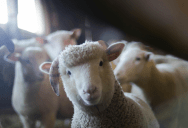Almost Three Decades Ago Scientists Successfully Cloned A Mammal. To Everyone’s Surprise, The Clone Went On To Live A Normal Life.

It’s the stuff of science fiction: real life walking, breathing clones populating the earth. It sounds unlikely, or at least like something from the far off future.
But did you know that scientists have had the ability to clone fully-grown mammals for decades?
In fact, the first successful cloning of a mammal happened over a quarter of a century ago, in June 1996.
Dolly the sheep was the result of this successful experiment from the University of Edinburgh, Scotland, whose task it was to genetically engineer the perfect livestock, as IFLScience explain, in a recent article.
The research team at the Roslin Institute – headed up by biologists Keith Campbell and Ian Wilmut – used a revolutionary technique that doesn’t involve fertilizing an egg with a sperm cell.

This technique, known as somatic cell nuclear transfer, instead triggers the development of an embryo using electricity. The embryo is developed from cells taken from two adult sheep.
Here, the nucleus from the cell of one adult sheep was implanted into an unfertilized egg cell from another adult sheep.
Once the embryo had been created, using that electrical wave, it was grown inside a surrogate sheep.
The sheep’s gestation period was exactly the same as that of a normal sheep; Dolly was born just like all the other lambs that season – except that she was a clone.
A lamb cloned was a massive scientific success – right? Well, yes, it was a huge success.
And this has informed massive scientific breakthroughs, with plenty of other mammals successfully cloned in the decades since.
However, the process is difficult, and – as IFLScience report – Dolly was the one solitary success out of a grand total of 277 attempts.
Given the stress caused to the sheep that carries the embryos, and possible complications and suffering during the life of the clone, there are some ethical considerations when it comes to cloning.

As a species, we must consider the implications of the cloning process which, at its most extreme, could one day be used to clone humans – something that could result in the nightmares that have, until now, been restricted to the entertainment of science fiction fans.
But what was Dolly’s life like? Well, besides the unusual methods of her conception, she was allowed to live a relatively normal life for a sheep.
She stayed in good health for most of her life, and even had six lambs of her own.
However, she was euthanized in 2003 at the age of six due to tumors on her lungs; the same tumors had developed on the lungs of another cloned sheep before Dolly’s death, leading to concern around the health of and risk to cloned animals.
Since her death, Dolly has been on display at the National Museum of Scotland, where she has no doubt inspired countless scientists of the future.
Cloning is no longer just the stuff of science fiction, as Dolly and her legacy show visitors to the museum every day.
If you thought that was interesting, you might like to read about a second giant hole has opened up on the sun’s surface. Here’s what it means.

Sign up to get our BEST stories of the week straight to your inbox.




